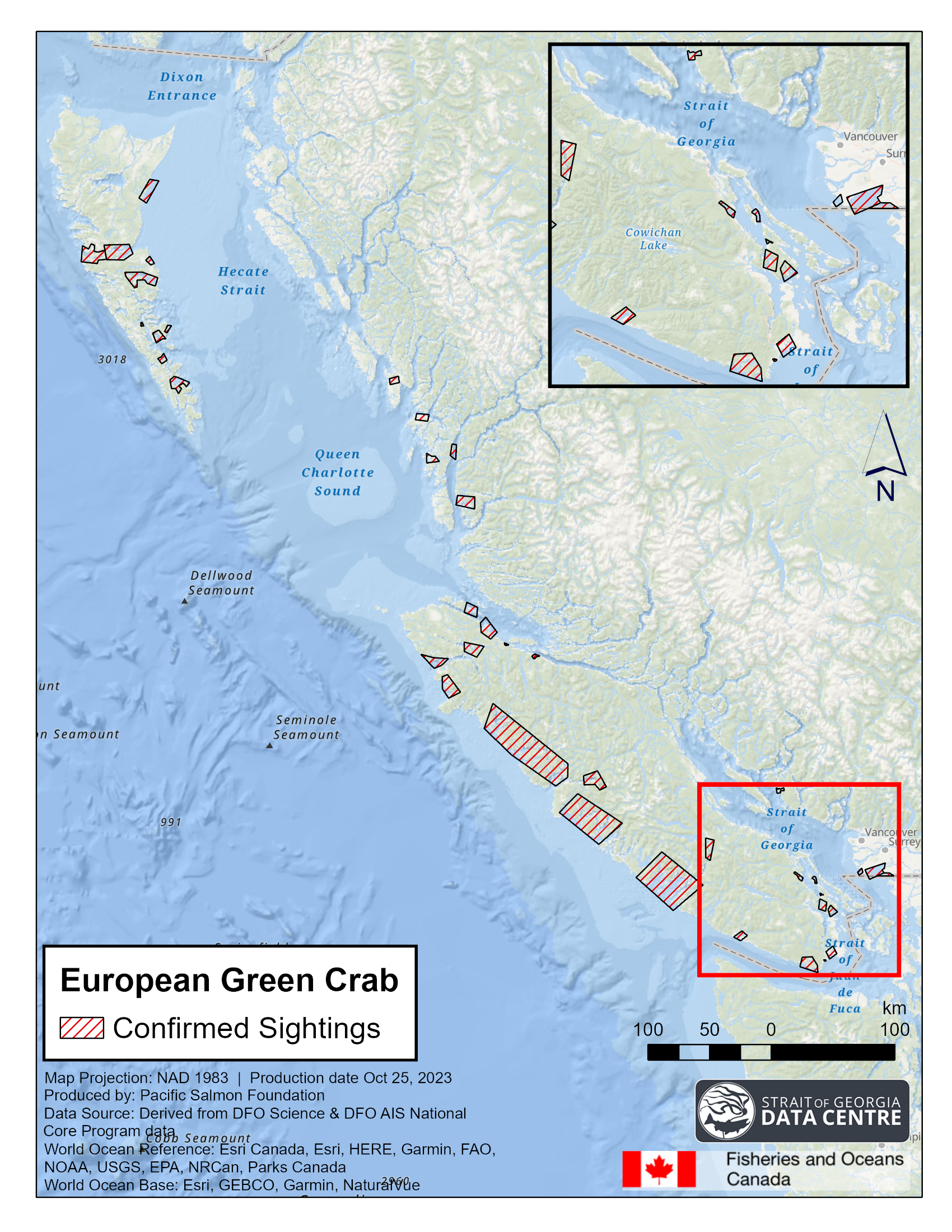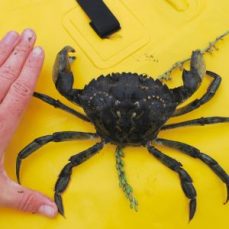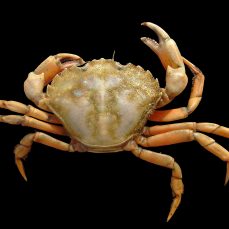
Photo credit: Hans Hillewaert
Management Category
Squamish
Whistler
Pemberton
Vectors of Spread
ID Characteristics
General: The European green crab is an aggressive crab that originates from Europe and Northern Africa.
Size: Adults can reach up to 10 cm.
Behaviour: Aggressive and territorial.
Colour: Carapace colour is variable but usually a mottled, dark brown or green.
Shell Shape: Shell is serrated and trapeze-shaped with three spines between the eyes and five on each side.
Claws and Legs:
- Walking legs are green and speckled with black. The second and third pair of walking legs are the longest and a little bit larger than the carapace. The fourth pair of legs are a bit shorter than the first and are somewhat flattened with setae (bristle-like structures).
- Claws are different sizes and the back legs are pointed, slightly flattened and hairy.
Life Span: 4-7 years.
Similar Species
Shore crabs (multiple species): they have 3 spines of each side of eyes and are much smaller (3.5 cm) than the European green crab.

Hairy shore crab (Photo: Gcau, CC BY-SA 4.0)
Northern kelp crab (Pugettia producta): have a pronounced pointy nose and their shell is longer than it is wide.

Photo: D. Gordon E. Robertson
Dungeness crab (Metacarcinus magister): has 10 spines on each side of eyes and is bigger (20cm) than the European green crab.

Photo: Crabmanners, CC BY-SA 4.0
Habitat and Origin
Origin: The European green crab is native to Europe and Northern Africa. It was first introduced to North America in the 1800s, likely from an European merchant ship that unintentionally transferred some crab-infested ballast water. This species was first found in Canadian waters in 1951 in New Brunswick. The European green crab arrived in B.C. in the late 1990’s; they likely came from larvae drifting on currents flowing northwards from south of our border.
Recently, scientists have discovered that there are two different types of European green crabs found in eastern Canada. The crabs found in northern waters are better able to survive in colder waters because they likely came from a Northern European stock.
Habitat: The European green crab can tolerate a wide range of water temperatures and salinities. Common in salt marshes, sandy beaches or rocky coasts – this crab prefers sheltered areas. The European green crab is often found on muddy, sandy or pebble ocean floors or in vegetation.
How it Spreads
Females can release up to 185,000 eggs once or twice per year.
The European green crab undergoes a prolonged larval stage (50-80 days), which enables it to drift with the currents and settle in new areas or survive in ballast water tanks. The European green crab is also very resilient and can survive out of water for over 5 days. This allows it to easily hide in fishing gear and equipment or at the bottom of crates, buckets and boats.
Impacts
Economic:
- It feeds on native shellfish, so it poses a grave risk to shellfish aquaculture.
- Managing green crab populations incurs substantial costs.
- The presence of green crabs reduces the availability of native crabs and lobsters, directly affecting the fishing industry’s harvest.
Ecological:
- It outcompetes many native species.
- It destroys beds of shellfish, and feeds on native animals including clams, oysters, mussels, small, fish, juvenile crabs and other crustaceans.
- It damages eelgrass beds, which are an important temporary home for juvenile salmon. Damaging eelgrass beds damages salmon populations. The loss of eelgrass beds can increase up to four times when exposed to high green crab densities.
Prevent the Spread
European green crabs have been found along the West and Central Coasts of Vancouver Island, but have not been found in the Strait of Georgia, nor Howe Sound so PREVENTION is key:
- Clean, Drain and Dry all aquatic equipment and vessels.
- Report potential green crab sightings
Control
European green crab can be controlled by:
- Mechanical control: Sustained trapping and removal. In some areas, Fisheries and Oceans Canada distributes nuisance permits to fishermen. Fishermen who have these permits may destroy any Green Crabs they catch in an effort to reduce population size.
- Biological control: Predators of green crabs are other crabs, fish species, birds, mink otters, seals, etc. A parasite was considered for use as a biocontrol agent in BC, but was deemed inappropriate due to the risk of off-target damage.
B.C. Distribution
European Green Crab Factsheet
Additional Resources
References
- Department of Fisheries and Oceans Canada, European Green Crab
- E-Fauna BC: Electronic Atlas of the Fauna of British Columbia, European Green Crab
- Adams, J., & Grason, E. (2017, January 25). Eyes on the beach and boots on the mud – european green crab monitoring on our coastline [Webinar]. In ISCBC Webinar Series.
- Government of Canada, European Green Crab
- Invasive Species Centre, European Green Crab
- Invasive Species Council of BC, European Green Crab
- NOAA, Look out for this invasive crab
- Pacific Salman Foundation, European Green Crab
- Sea Grant Washington, European Green Crab
- USDA, European Green Crab
- Washington Department of Fish & Wildlife, European Green Crab















